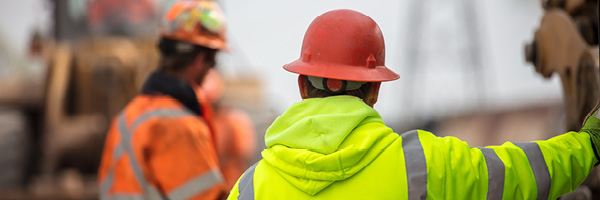
This article is part of a series Grange Insurance is creating to help business owners improve safety while reopening their businesses during COVID-19.
As you begin to resume construction during coronavirus, it’s important that your working operations don’t return to the “normal” you knew before COVID-19. Create a construction reopening plan to spell out the safety precautions your company will take to help prevent the spread of COVID-19 during construction.
Create a construction reopening plan
As you create your plan, monitor local and state guidelines and look to experts like the Centers for Disease Control and Prevention (CDC), Occupational Safety and Health Administration (OSHA) and American Industrial Hygiene Association (AIHA). These organizations can help you determine best practices to follow before, during and after your construction workday to help protect your crew and others from the spread of COVID-19, including guidelines for handwashing, disinfecting shared surfaces and wearing face masks.
Using these resources, construction employers should create their own construction reopening plan and communicate the plan to employees in different forms. Send the plan to workers’ emails and post it in shared spaces on job sites for easy access throughout the day. Your construction reopening plan should include details that:
- Encourage sick employees to stay home.
- Require employees with COVID-19 symptoms to follow CDC guidelines and their healthcare provider’s recommendations before returning to work.
- Provide employees with accurate information on COVID-19 and updates.
- Explain protective measures that will be put in place at each job site.
Continue monitoring local, state, federal and global coronavirus guidelines for changes in recommendations and other best management practices. Then update your construction reopening plan and COVID-19 response posters, emails and other communications as necessary.
Construction and coronavirus: Before the workday
Explain to your construction crew how they should assess their health before coming to work each day. For example, if they feel sick or they are experiencing any symptoms of COVID-19, such as a fever above 100.4 degrees Fahrenheit, they should stay home and inform their supervisor and then consult with their healthcare provider to seek treatment options.
At the construction site, consider taking other precautions like checking employees’ temperatures before work and providing personal protective equipment (PPE), such as a face mask or face shield and hand sanitizer with at least 60% alcohol. Provide training and post reminders on site, if possible, to help everyone follow new safety guidelines and procedures.
It’s also important to provide a safe and clean working environment. Shared surfaces and areas should be disinfected before starting the workday. The CDC recommends cleaning and disinfecting frequently touched surfaces such as shared tools, machines, vehicles and other equipment, handrails, ladders, doorknobs and portable toilets. It also recommends limiting the number of workers in small workspace areas such as job site elevators, trailers and vehicles, or spaces under construction if at all possible.

Learn about our
Business Insurance
Construction and coronavirus: On the job site
Ask your construction crew and employees to take precautions to help slow the spread of COVID-19, such as:
- Maintaining a distance of at least six feet apart from others when possible.
- Reducing the number of people carpooling to job sites.
- Using mobile handwashing stations or hand sanitizer with at least 60% alcohol when soap and warm water are not available.
- Wearing a cloth face mask or face covering as much as possible. However, cloth face coverings are not appropriate substitutes at work sites where masks or respirators are recommended or required.
Workers should also take part in sanitizing shared tools and surfaces throughout the workday, such as when they are done using an area or a piece of equipment. Keep the right disinfecting resources (e.g., cleaning spray and paper towels) on site and provide training, and PPE if appropriate, to establish a disinfection procedure that is done safely and effectively. Consider initiating an end-of-day cleaning routine, so workers come back to a disinfected environment the next business day.
Here are additional steps your company can take to manage construction during coronavirus and put the health and safety of your workers first:
- Stagger work schedules so there are less workers at a job site at any given time. Alternating workdays and adding extra shifts can help as well.
- Install plexiglass barriers wherever possible and sanitize them regularly.
- Restrict the number of people allowed in small areas at one time.
- Rearrange workstations so they are at least six feet apart.
- Reduce the number of in-person meetings. If they are necessary, try to limit the number of people and ask everyone to stand at least six feet away from each other.
- Continue to conduct hazard assessments and make changes to job sites as necessary.
References:
- American Industrial Hygiene Association (AIHA)
- Centers for Disease Control and Prevention (CDC)
This article is for informational and suggestion purposes only. If you have questions about your Grange business insurance coverage, please speak with your independent insurance agent.